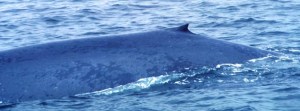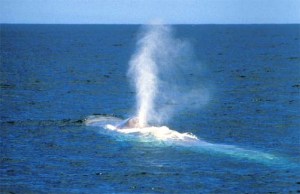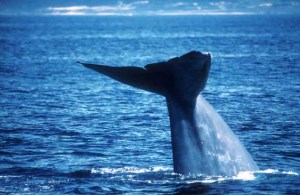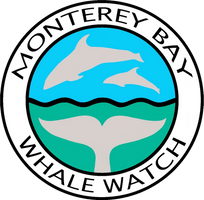BLUE WHALES ARRIVE IN MONTEREY BAY

Blue Whales, the largest animals to ever live on earth at lengths up to 100 feet, are currently feeding in Monterey Bay. On July 22, marine biologists from Monterey Bay Whale Watch counted at least 30 blue whales feeding on the north rim of Monterey’s Submarine Canyon. Lead biologist, Nancy Black, sighted groups of 2 to 3 blue whales dispersed out over several miles near the canyon edge. Passengers aboard Monterey Bay Whale Watch’s vessel, the Sea Wolf II, were ecstatic with excitement as a group of 2 whales surfaced alongside the 70-foot boat where it became obvious to everyone that the whales were at least 20 feet longer than the boat!
Blue Whales, once hunted to the brink of extinction, number about 2,200 individuals in the population that feeds off the California coast during the summer, with only about 10,000 worldwide. Just in the last few years, scientists studying these whales have located their wintering grounds, which are several hundred miles off Costa Rica. By photographically identifying each whale sighted off California, then identifying whales offshore of Costa Rica, researchers have matched several whales between the two areas. In addition, satellite tags placed on blue whales off California have revealed critical information about their migratory patterns.

Monterey Bay is a prime feeding area for Blue Whales from June through November. Blue whales occur in the Bay when krill is most abundant. Krill is a small shrimp-like animal, or crustacean, and is the only food item consumed by the blue whale. Several species of krill occur off California and swarm together in large masses. Blue whales can feed on up to 4 tons of krill every day. Central California, including Monterey Bay, is a major upwelling region, with only 4 or 5 other intense upwelling zones in the world. Upwelling regions are areas of extremely high productivity, resulting in massive plankton blooms providing the base of the food chain. In addition to blue whales, humpback whales, fin whales, minke whales, killer whales and a variety of dolphin species feed in Monterey Bay.

Currently, the blue whales in Monterey Bay are feeding on krill at depths of around 400 feet near the canyon edge. Monterey Bay’s submarine canyon is the largest and deepest canyon on the west coast and the only one found close to shore. Krill tend to concentrate along the canyon edge, resulting in a higher concentration of blue whales there compared to other areas in the Bay. Since 1986, biologists from Monterey Bay Whale Watch have recorded sighting locations of these whales, photographically identified individual whales, and collaborated with other researchers who study blue whales. This information is on-going and used to estimate the whale population, determine at what rate it is increasing each year, and define critical feeding habitats and oceanographic conditions favorable to the occurrence of the blue whales.
